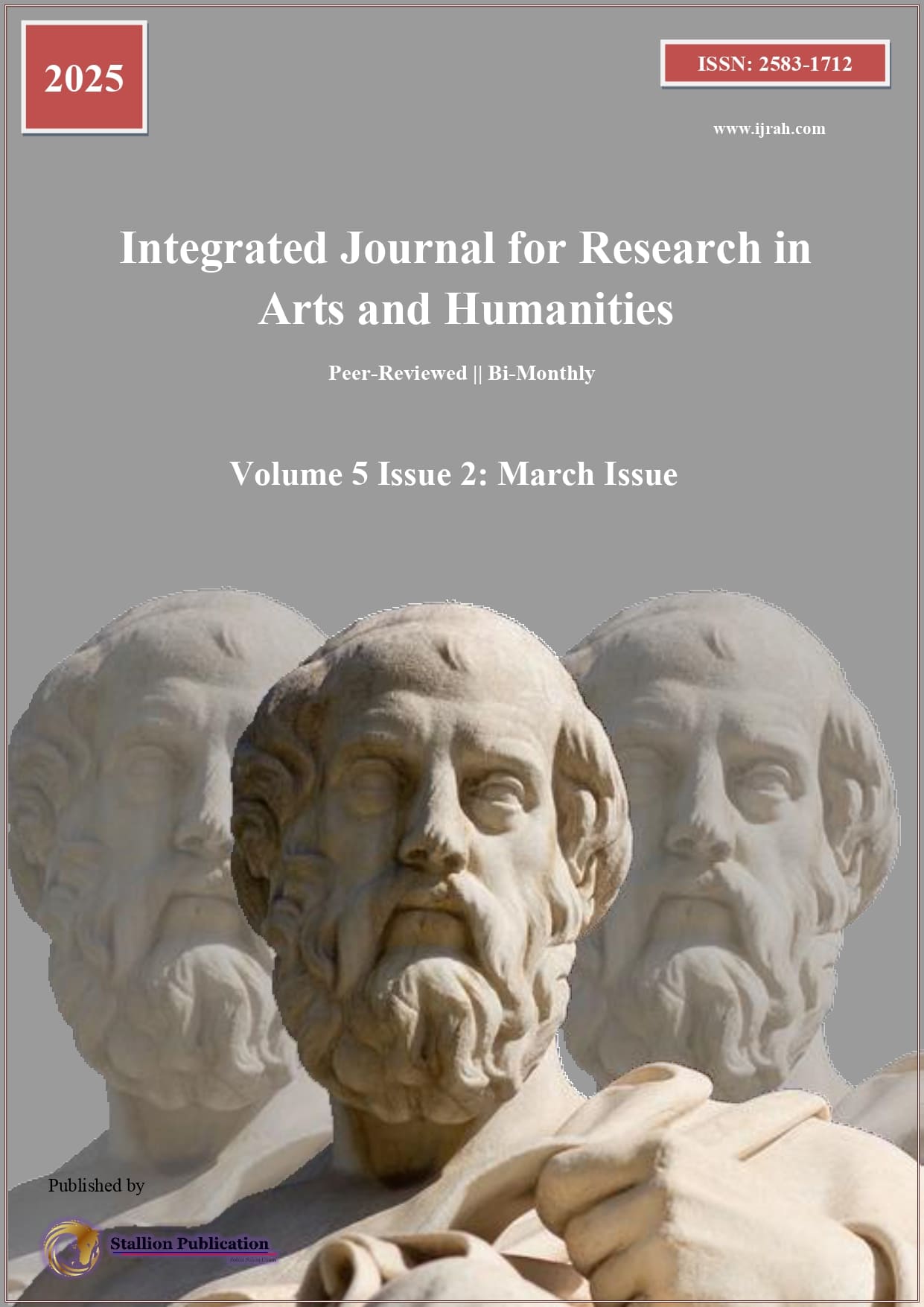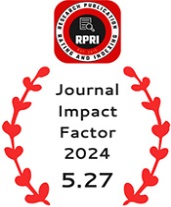Self-Confidence and Aggression: A Comparative Study Between Throwers and Jumpers
DOI:
https://doi.org/10.55544/ijrah.5.2.40Keywords:
Aggression, Self-Confidence, Throwers, JumpersAbstract
This study examined the levels of aggression and self-confidence among athletes who throw and jump. Sixty athletes from Hemvati Nandan Bahuguna Garhwal University, 30 of whom were throwers and 30 of whom were jumpers, were chosen for the study. They ranged in age from 18 to 25. The Self-Confidence Inventory (Basavanna, 1975) was used to gauge the athletes' self-confidence, and the Buss and Perry Aggression Questionnaire (BPAQ, 1992) was used to gauge their aggression. The data were analysed using independent t-tests and descriptive statistics, with a significance level of 0.05. The findings showed that throwers and jumpers did not significantly differ in their levels of self-confidence. Jumpers scored slightly higher on the self-confidence scale, but the difference was not statistically significant (t = 1.86, p = 0.07). Aggression levels, however, differed significantly, with throwers being more aggressive than jumpers (t = 3.42, p = 0.01). In contrast to the more technical and regulated demands of jumping events, this finding implies that throwing events' physical demands and competitive nature encourage higher levels of aggression. It was found that although both groups have similar degrees of self-confidence, throwers often show more aggression because of the inherent nature of their particular sports. These findings can guide the creation of sport-specific psychological training courses, especially in controlling aggression for throwers and boosting self-confidence in both groups.
Downloads
References
Basavanna, M. (1975). Manual for Self-Confidence Inventory. Varanasi: Rupa Psychological Centre.
Buss, A. H., & Perry, M. (1992). The Aggression Questionnaire. Journal of Personality and Social Psychology, 63(3), 452–459. https://doi.org/10.1037/0022-3514.63.3.452.
Coach's Guide to: Building Athlete Self-Confidence. (n.d.) Retrieved April 27, 2025, from sportpsychologywriter.medium.com.
Cox, R. H. (2002). Sport Psychology: Concepts and Applications (5th ed.). New York: McGraw-Hill.
Creating Confidence – The Four Sources of Self-Efficacy. (n.d.) Retrieved April 27, 2025, from coachesinsider.com.
Developing Self-Confidence | BETTER COACHING. (n.d.) Retrieved April 27, 2025, from www.betteryouthcoaching.com/developing-self-confidence.
Dibba, D., & Vijaymohan, N. (2022). A comparative study of aggression between university-level batters and bowlers. International Journal of Creative Research Thoughts (IJCRT), 10(3), 201–203. https://www.ijcrt.org.
DINKAR, D. K. & SHRI KRISHNA SHARIRIK SHIKSHAN MAHAVIDYALAYA WARDHA. (2022). A comparative study on the skill of psychological and motor fitness components on selected variables among jumpers and throwers. In International Journal for Research Trends and Innovation (Vol. 7, Issue 7, pp. 1245–1246) [Journal-article]. https://www.ijrti.org.
Gill, D. L. (2000). Psychological dynamics of sport and exercise. Human Kinetics.
Grimmer M, Bingham T. Company environmental performance and consumer purchase intentions. J Bus Res. 2013;66(10):1945-53.
KALFS, C.E., ARUTHEIM, C.D., 1969, Modern Principles of Athletics Training, St.Louis: C.V. Mosby Company, p.117.
Kanthraj, S. & CBR National College of Law. (2016). A comparative study of aggression between Contact Game and Non-Contact Game players of Karnataka. International Journal of Research and Analytical Reviews, 3(2), 753–754. https://www.ijrar.org.
Kerr, J. H. (1999). Motivation and emotion in sport: Reversal theory. Psychology Press.
Legesse, A. K., PhD, Melaku, Y. M., Tirunesh Dibaba Training Center, & Ethiopia Sport Academy. (2022). IMPACT OF SELF-CONFIDENCE AND SPORTIVE AGGRESSION TOWARDS THE ATHLETIC PERFORMANCE OF AN ATHLETE: TIRUNESH DIBABA ATHLETICS TRAINING CENTER. Sucharitha Publication. http://ijmer.in/pdf/e-Certificate%20of%20Publication-IJMER.pdf.
Maxwell, J. P., Visek, A. J., & Moores, E. (2009). Anger and perceived legitimacy of aggression in male Hong Kong Chinese athletes: Effects of type of sport and level of competition. Psychology of Sport and Exercise, 10(2), 289–296. https://doi.org/10.1016/j.psychsport.2008.08.003.
Reddy, J. S. (1 C.E.). Virtual reality and simulation in physical education. International Journal of Health, Physical Education and Computer Science in Sports, 3(1), 1–3.
RELATIONSHIP BETWEEN SELF CONCEPT AND .... (n.d) Retrieved April 27, 2025, from www.jetir.org/papers/JETIR1905I51.pdf.
Seema & IJPESH. (2024). The psychology of competition: Exploring aggression in sprinters, jumpers, and throwers. In International Journal of Physical Education, Sports and Health (Vol. 11, Issue 2, pp. 333–335) [Journal-article]. https://www.kheljournal.com.
Silva, J. M. (1983). The perceived legitimacy of rule-violating behavior in sport. Journal of Sport Psychology, 5(4), 438-448. https://doi.org/10.1123/jsp.5.4.438.
Singh, R., & Gupta, S. (2019). Psychological profiles of athletes across different sports. Indian Journal of Sports Science, 15(2), 55–62.
Smith, R. E., & Smoll, F. L. (2007). Coaching behavior and children's self-esteem: A longitudinal study. Journal of Sport and Exercise Psychology, 29(3), 1-15. https://doi.org/10.1123/jsep.29.3.1.
Tenenbaum G, Eklund RC. Handbook of Sport Psychology. John Wiley & Sons; 2020.
Tenenbaum, G., Stewart, E., Singer, R. N., & Duda, J. (1997). Aggression and violence in sport: An ISSP position stand. The Sport Psychologist, 11(1), 1-7. https://doi.org/10.1123/tsp.11.1.1.
The effects of self-talk on throwing- and jumping-events .... (n.d). Retrieved April 27, 2025, from www.researchgate.net.
The Relationship Between Self-Confidence and Performance. (n.d.) Retrieved April 27, 2025, from www.trine.edu.
Tomar, R., & Singh, R. (2012). AGGRESSION IN ATHLETICS: A COMPARATIVE STUDY. In Ovidius University, Ovidius University Annals, Series Physical Education and Sport / SCIENCE, MOVEMENT AND HEALTH (p. 31). https://www.analefefs.ro/anale-fefs/2012/issue-1/pe-autori/5.pdf.
Vealey, R. S. (1986). Conceptualization of sport-confidence and competitive orientation: Preliminary investigation and instrument development. Journal of Sport Psychology, 8(3), 221–246. https://doi.org/10.1123/jsp.8.3.221.
Weinberg, R. S., & Gould, D. (2015). Foundations of sport and exercise psychology (6th ed.). Human Kinetics.
Why Confidence Matters. (n.d.) Retrieved April 27, 2025, from coachesinsider.com/track-x-country/why-confidence-matters/.
Downloads
Published
How to Cite
Issue
Section
License

This work is licensed under a Creative Commons Attribution-NonCommercial-NoDerivatives 4.0 International License.




















